Analysis and Control of Optimal Power Distribution for Multi-Objective Wireless Charging Systems
Abstract
1. Introduction
2. Mathematic Model
3. Load Adjustment and Power Distribution
3.1. Analysis of Power Distribution
3.2. Principle of Load Adjustment
3.3. Methodology of Load Adjustment
| Algorithm 1 |
| Initialize(Rexmax, Rexmin, iexmax) |
| while(ture) do // find the optimal value by dichotomy. |
| input(Iex) // use the excitation current to detect total equivalent impedance variation. |
| if(Iex > Iexmax) break // if there is no charging load or the charging load is to heavy, close the system. |
| end if |
| if Iex > 1.5 × Iex0 // total equivalent impedance decreases sharply. |
| Rse←Uex/Iex − rex |
| R’se←(Rexmax + Rexmin)/2 // set the total equivalent impedance to the medium value. |
| Rexmin←Rse // set the current value as the minimum value. |
| Cp← |
| input(Iex) |
| Iex0←Iex // record the excitation current to detect if total equivalent impedance changes. |
| else if Iex < 0.066 × Iex0 // total equivalent impedance increases sharply. |
| Rse←Uex/Iex − rex |
| R’se←(Rexmax + Rexmin)/2 // set the total equivalent impedance to the medium value. |
| Rexmax←Rse |
| Cp← |
| input(Iex) |
| Iex0←Iex // record the excitation current to detect if total equivalent impedance changes. |
| end if |
| if t%50 = 0 |
| Initialize(Rexmax, Rexmin) //every 50 steps reinitialize Rexmax and Rexmin. |
| end if |
| t←t + 0.001 //each step cost 1 ms. |
| end |
| Algorithm 2 |
| Initialize(α, Prefi) |
| while(true) do |
| input(Prei) Urei← // calculate input voltage of the DC-DC converter. |
| if Prei ≠ Prefi |
| α← // if the power demand is not satisfied, adjust the duty ratio. |
| end if |
| t←t + 0.003 // each step cost 3 ms. |
| end |
4. Verification
4.1. Simulated Results
4.2. Experimental Results
5. Conclusions
Author Contributions
Acknowledgments
Conflicts of Interest
References
- Wang, C.S.; Grant, C.A.; Stielau, O.H. Power transfer capability and bifurcation phenomena of loosely coupled inductive power transfer systems. IEEE Trans. Ind. Electron. 2004, 51, 148–157. [Google Scholar] [CrossRef]
- Liu, X.; Hui, S.Y. Optimal design of a hybrid winding structure for planar contactless battery charging platform. IEEE Trans. Power Electron. 2008, 23, 455–463. [Google Scholar]
- Low, Z.N.; Chinga, R.A.; Tseng, R.; Lin, J. Design and test of a high-power high-efficiency loosely coupled planar wireless power transfer system. IEEE Trans. Ind. Electron. 2009, 56, 1801–1812. [Google Scholar]
- Jiang, C.; Chau, K.T.; Liu, C.; Lee, H.T.C. An overview of resonant circuits for wireless power transfer. Energies 2017, 8, 894. [Google Scholar] [CrossRef]
- Jang, Y.; Jovanović, M.M. A contactless electrical energy transmission system for portable-telephone battery chargers. IEEE Trans. Ind. Electron. 2003, 50, 520–527. [Google Scholar] [CrossRef]
- Chau, K.T.; Chan, C.C.; Liu, C. Overview of permanent-magnet brushless drives for electric and hybrid electric vehicles. IEEE Trans. Ind. Electron. 2008, 55, 2246–2257. [Google Scholar] [CrossRef]
- Lu, Y.; Brain, M.D. Wireless power transfer system architecture for portable or implantable applications. Energies 2016, 9, 1087. [Google Scholar] [CrossRef]
- Chau, K.T.; Chan, C.C. Emerging energy-efficient technologies for hybrid electric vehicles. IEEE Proc. 2007, 95, 821–835. [Google Scholar] [CrossRef]
- Rao, S.; Chiao, J.C. Body electric wireless power transfer for implant applications. IEEE Microw. Mag. 2015, 16, 54–64. [Google Scholar] [CrossRef]
- Lee, H.T.C.; Chau, K.T.; Liu, C. Design and Analysis of an Electronic-Geared Magnetless Machine for Electric Vehicles. IEEE Trans. Ind. Electron. 2016, 63, 6705–6714. [Google Scholar] [CrossRef]
- Zhang, Z.; Chau, K.T. Pulse-Width-Modulation-Based electromagnetic interference mitigation of bidirectional grid-connected converters for electric vehicles. IEEE Smart Grid 2017, 8, 2803–2812. [Google Scholar] [CrossRef]
- Giuseppe, B.; Manuele, B.; Kishore, N.M. Design and experimentation of WPT charger for electric city car. IEEE Trans. Ind. Electron. 2015, 62, 7436–7447. [Google Scholar]
- Zhang, Z.; Chau, K.T. Homogeneous wireless power transfer for move and charge. IEEE Trans. Power Electron. 2015, 30, 6213–6220. [Google Scholar] [CrossRef]
- Bu, Y.; Mizuno, T.; Fujisawa, H. Proposal of a wireless power transfer technique for low-power multi-receiver applications. IEEE Trans. Magn. 2015, 51, 1–4. [Google Scholar] [CrossRef]
- Hatanaka, K.; Sato, F.; Matsuki, H.; Kikuchi, S.; Murakami, J.; Kawase, M.; Satoh, T. Power transmission of a desk with a cord-free power supply. IEEE Trans. Magn. 2002, 38, 3329–3331. [Google Scholar] [CrossRef]
- Cheon, S.; Kim, Y.; Kang, S.; Lee, M.; Lee, J.; Zyung, T. Circuit-model-based analysis of a wireless energy-transfer system via coupled magnetic resonances. IEEE Trans. Ind. Electron. 2011, 58, 2906–2914. [Google Scholar] [CrossRef]
- Kiani, M.; Ghovanloo, M. The circuit theory behind coupled-mode magnetic resonance-based wireless power transmission. IEEE Trans. Circuits Syst. I Reg. Lett. 2012, 59, 1–10. [Google Scholar] [CrossRef] [PubMed]
- Imura, T.; Hori, Y. Maximizing air gap and efficiency of magnetic resonant coupling for wireless power transfer using equivalent circuit and Neumann formula. IEEE Trans. Ind. Electron. 2011, 58, 4746–4752. [Google Scholar] [CrossRef]
- Dai, X.; Li, X.; Li, Y.; Deng, P.; Tang, C. A maximum power transfer tracking method for WPT systems with coupling coefficient identification considering two value problem. Energies 2017, 10, 1665. [Google Scholar] [CrossRef]
- Zhang, Z.; Chau, K.T.; Liu, C.; Qiu, C.; Lin, F. An efficient wireless power transfer system with security considerations for electric vehicle applications. J. Appl. Phys. 2014, 115, 17A328. [Google Scholar] [CrossRef]
- Zhang, Z.; Chau, K.T.; Qiu, C.; Liu, C. Energy encryption for wireless power transfer. IEEE Trans. Power Electron. 2015, 30, 5237–5246. [Google Scholar] [CrossRef]
- Lee, K.; Cho, D. Analysis of wireless power transfer for adjustable power distribution among multiple receivers. IEEE Trans. Power Electron. 2015, 14, 950–953. [Google Scholar] [CrossRef]
- Lim, Y.; Tang, H.; Lim, S.; Park, J. An adaptive impedance-matching network based on a novel capacitor matrix for wireless power transfer. IEEE Trans. Power Electron. 2014, 29, 4403–4413. [Google Scholar] [CrossRef]
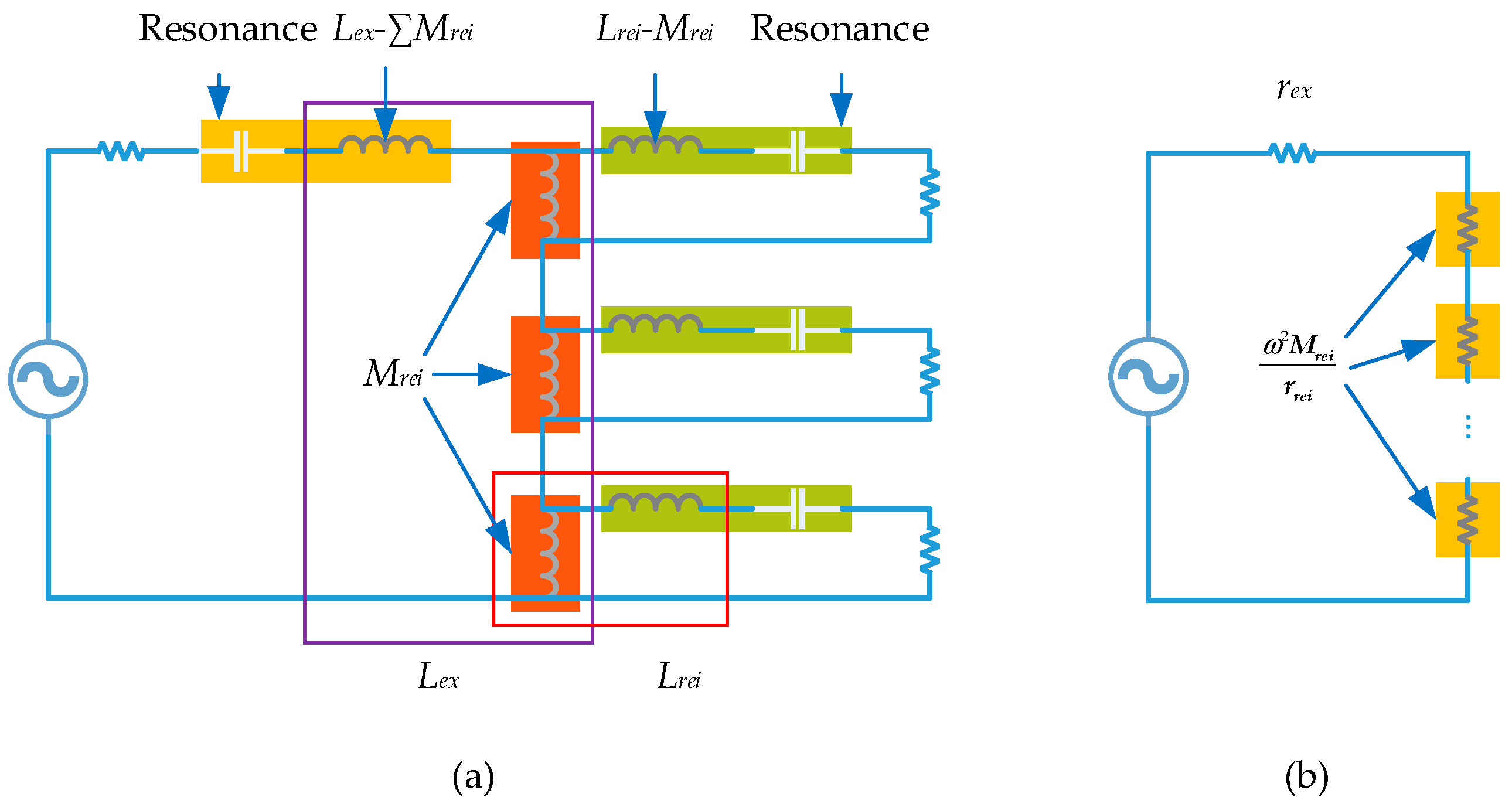

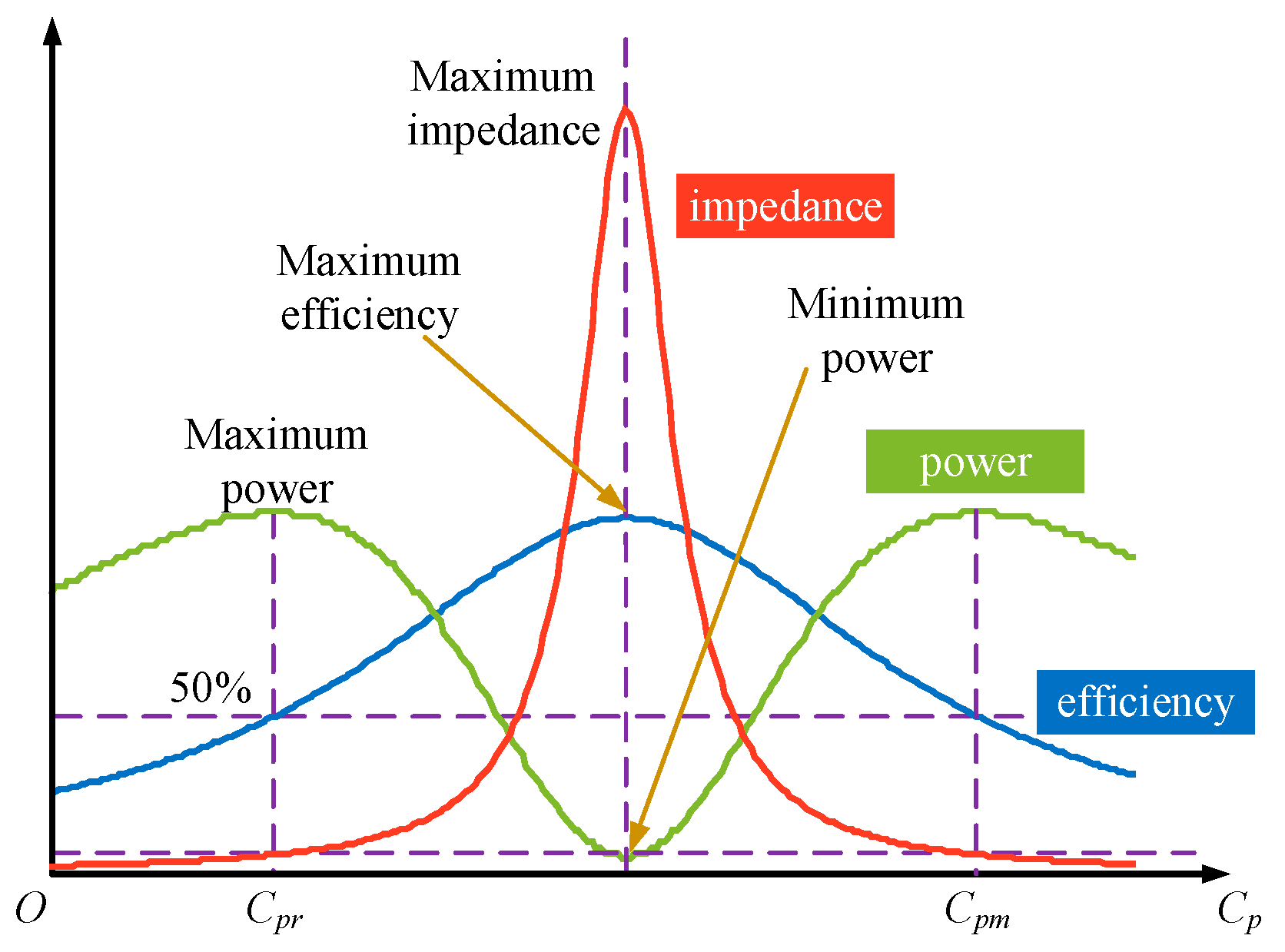

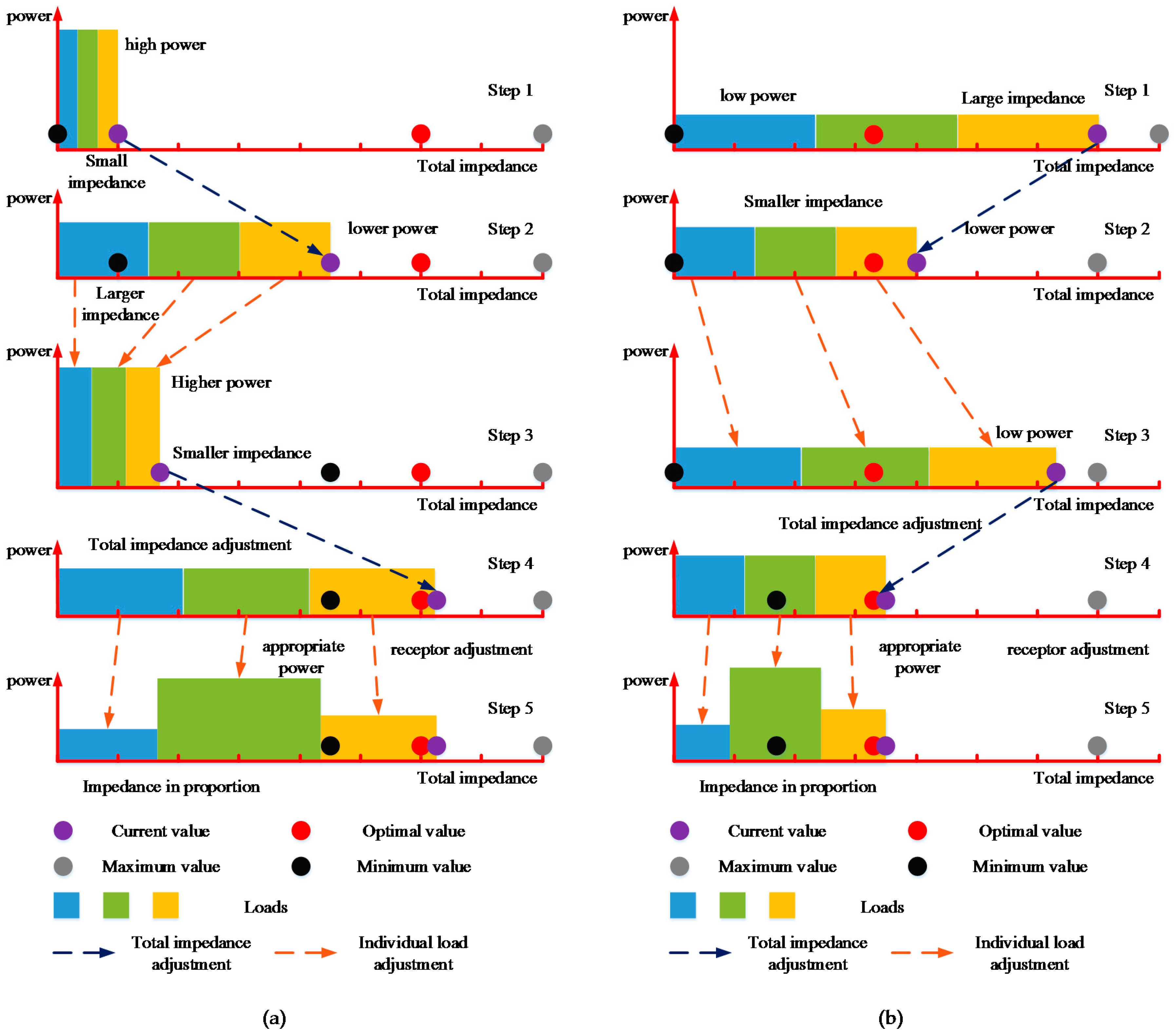
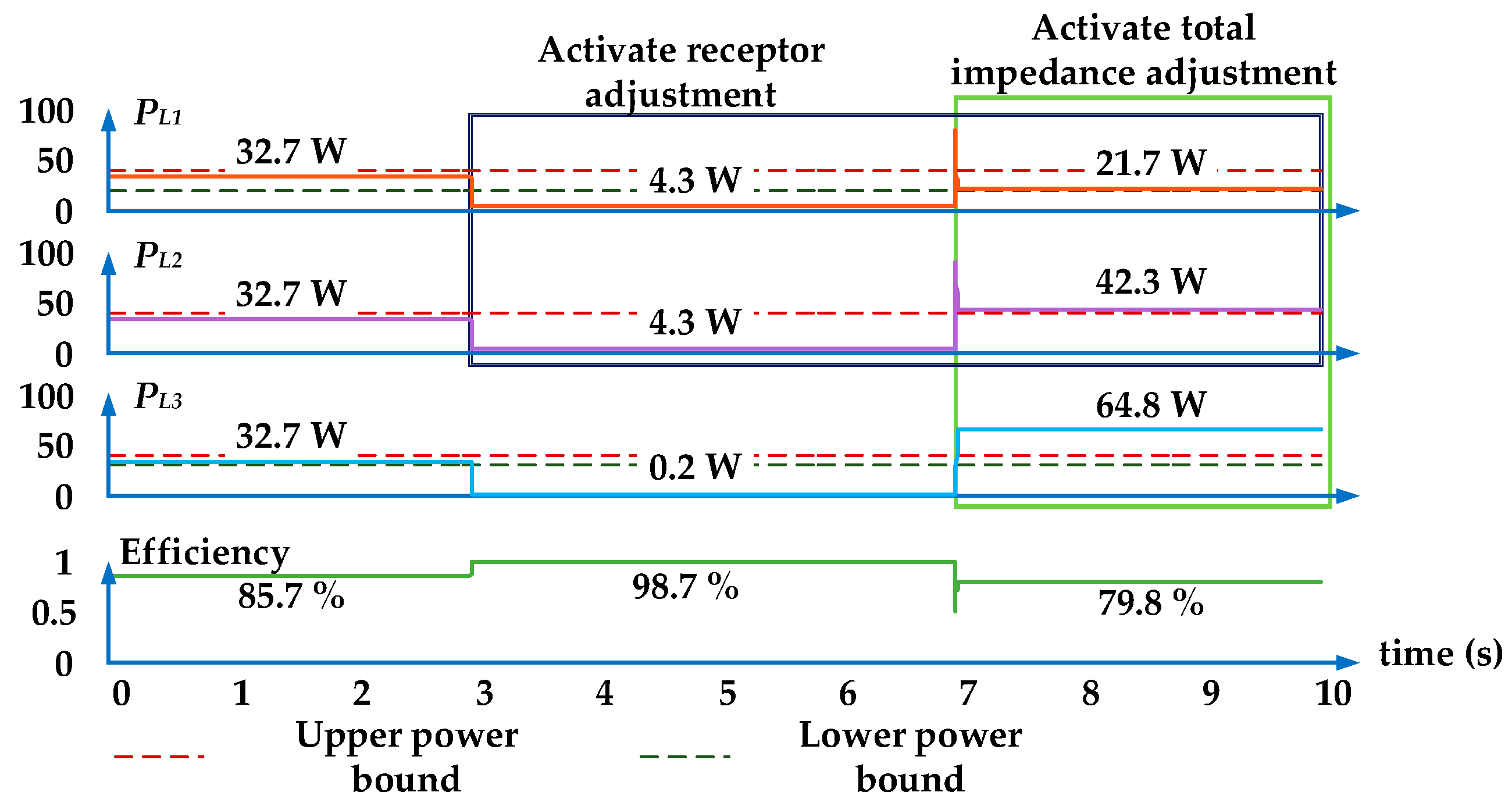
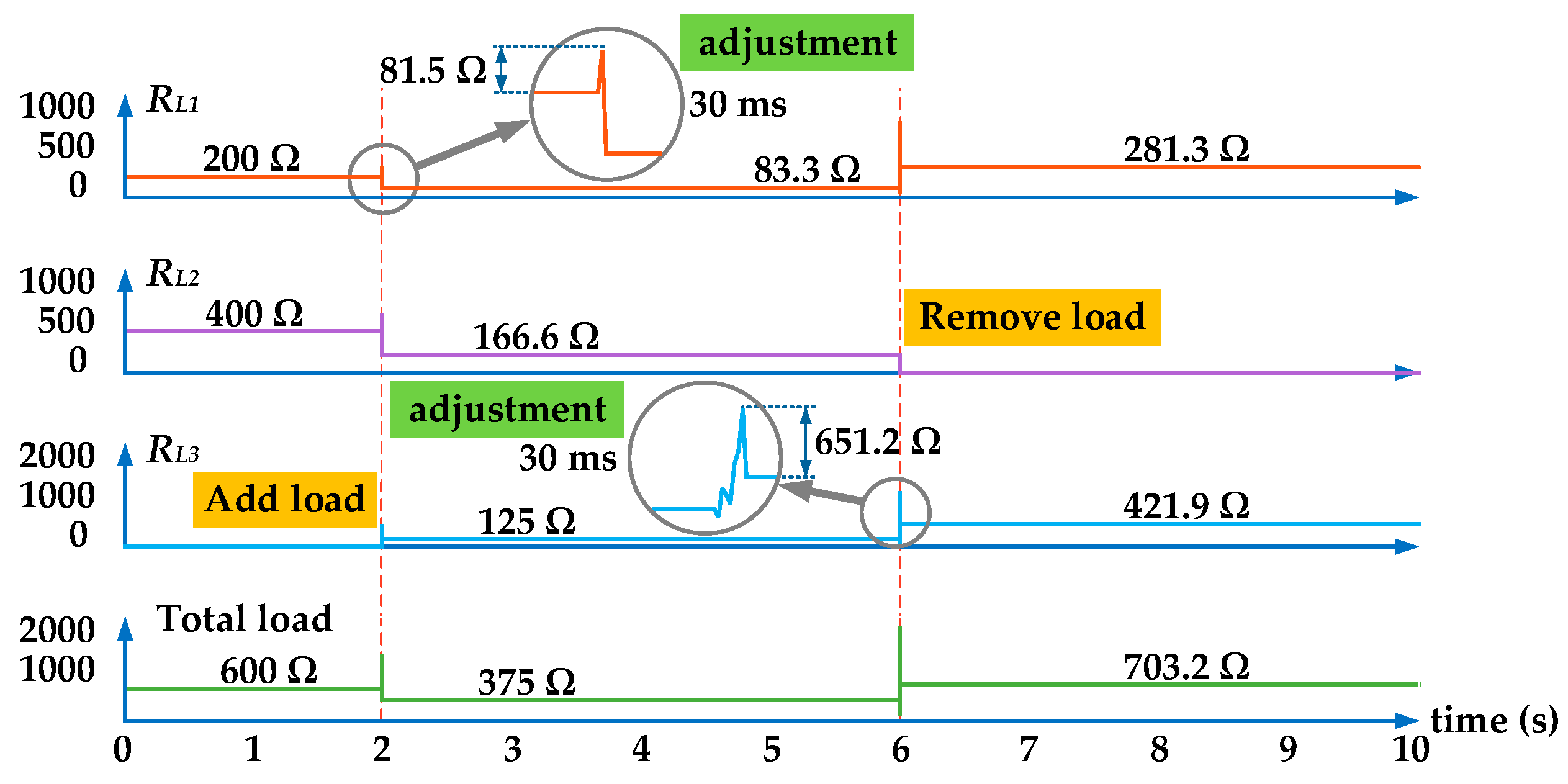
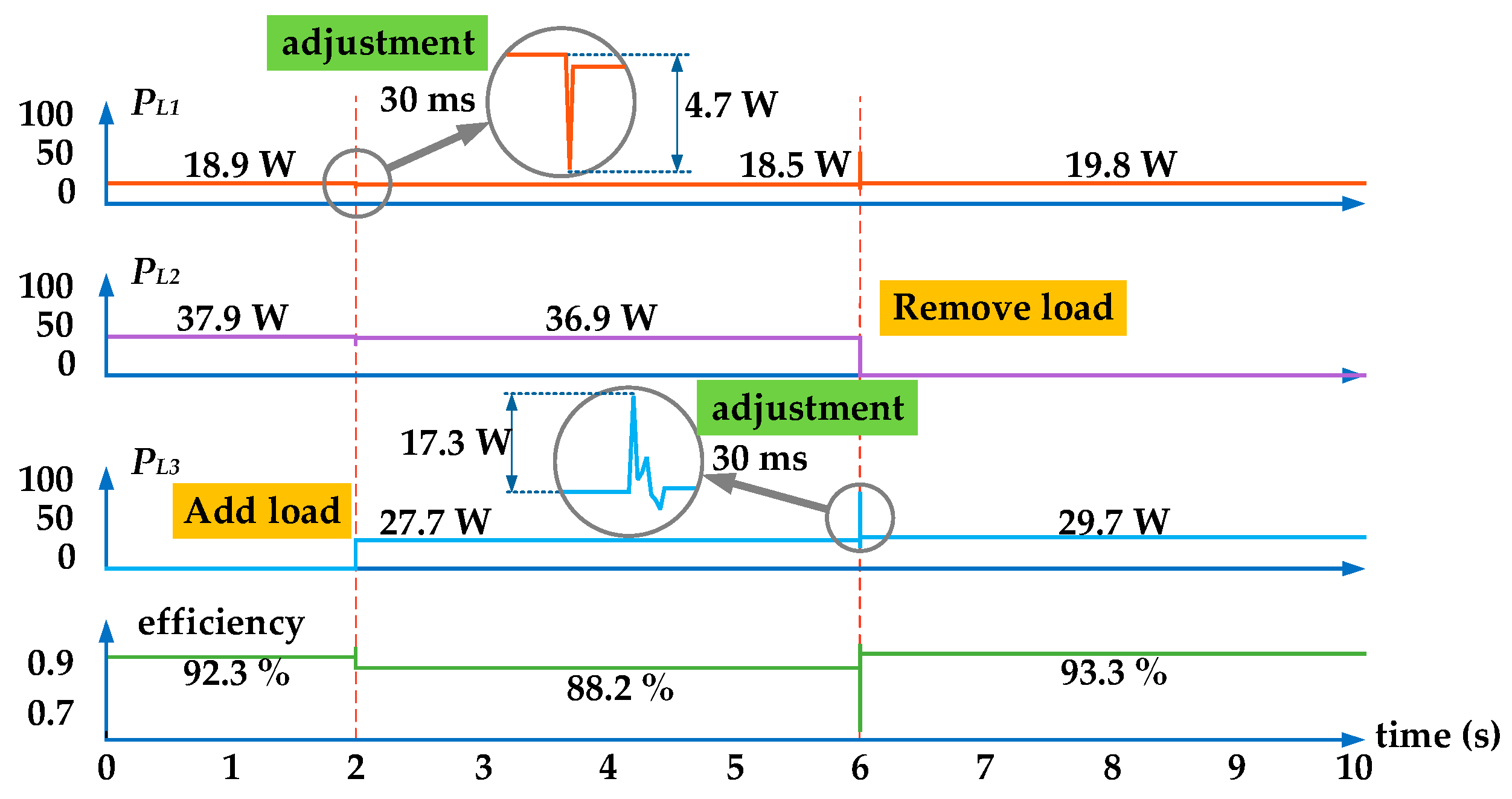
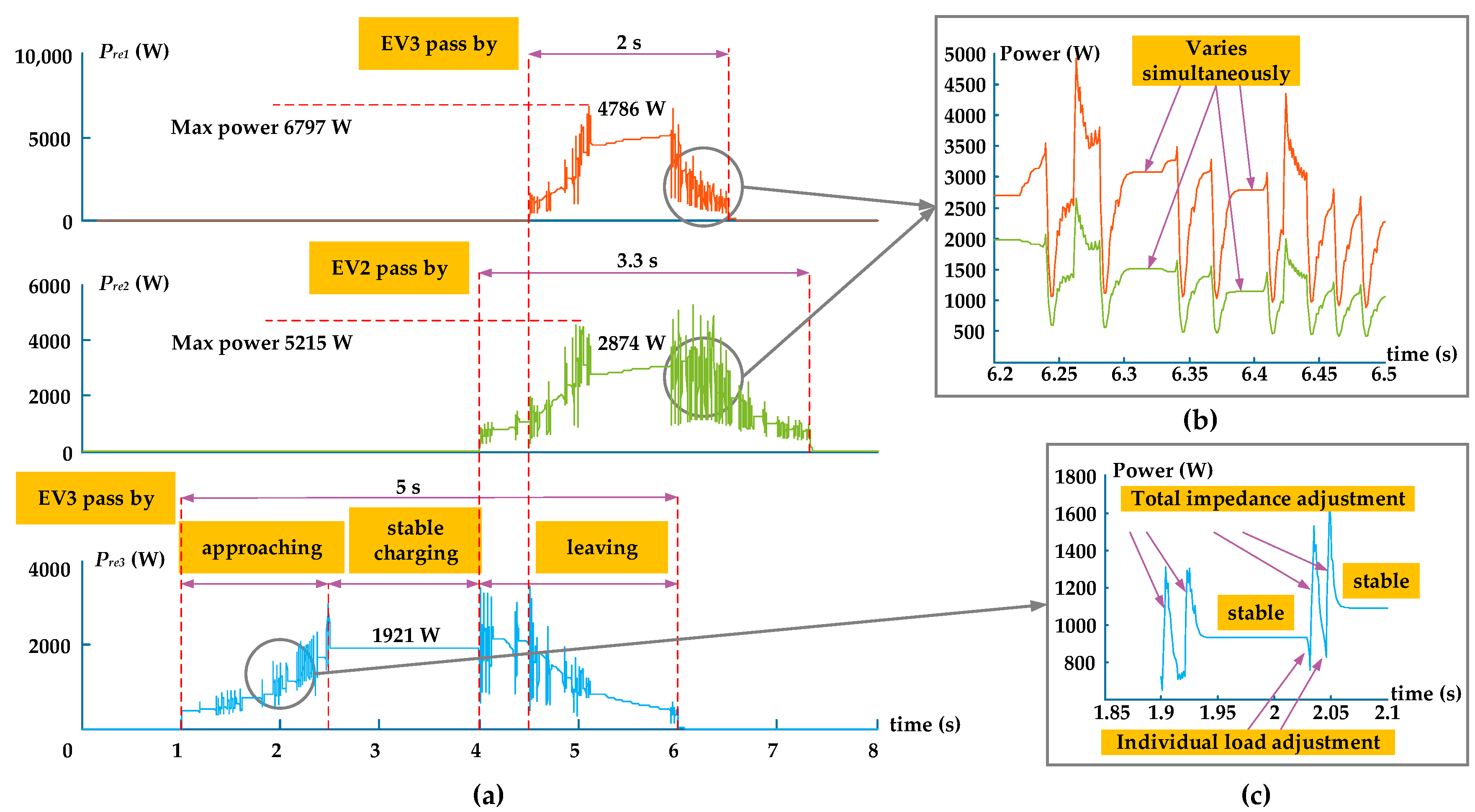

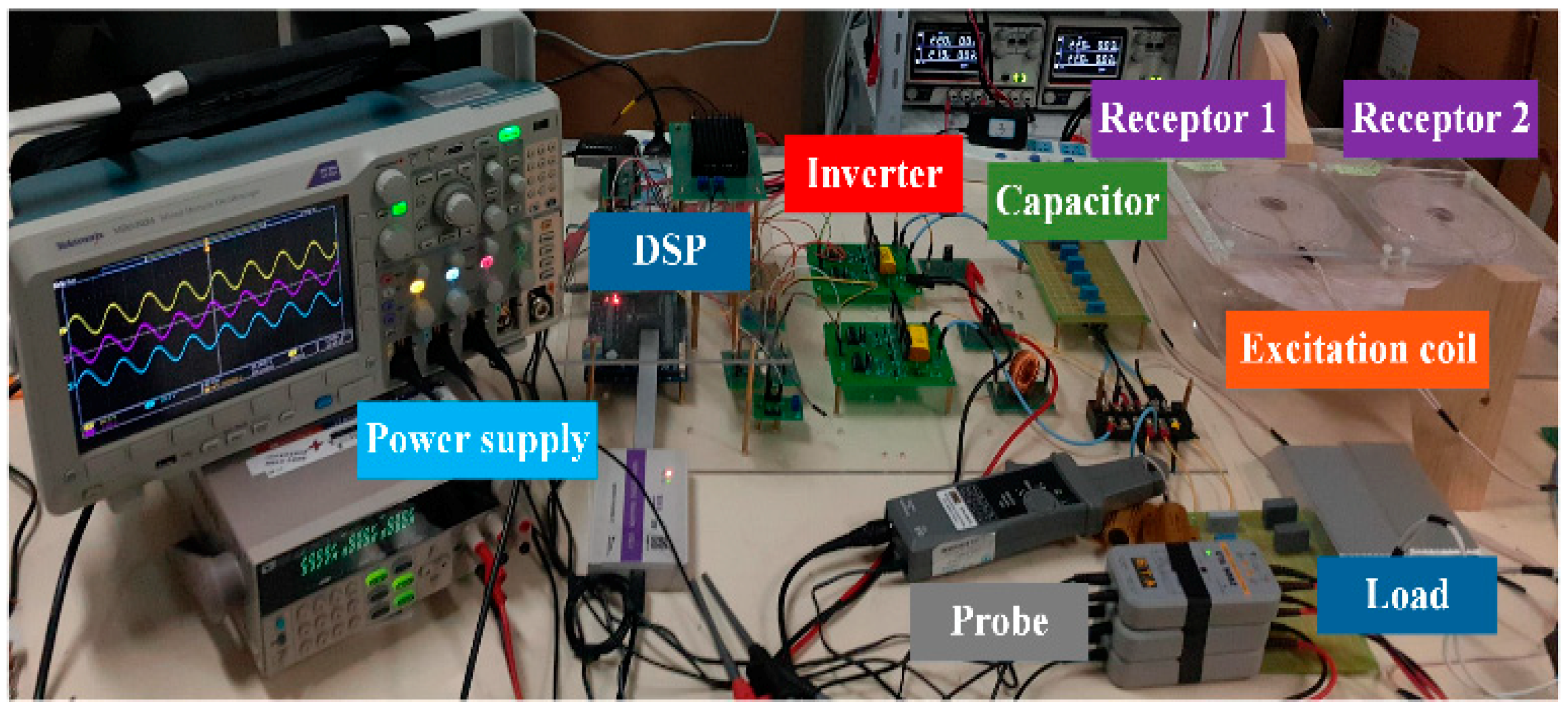
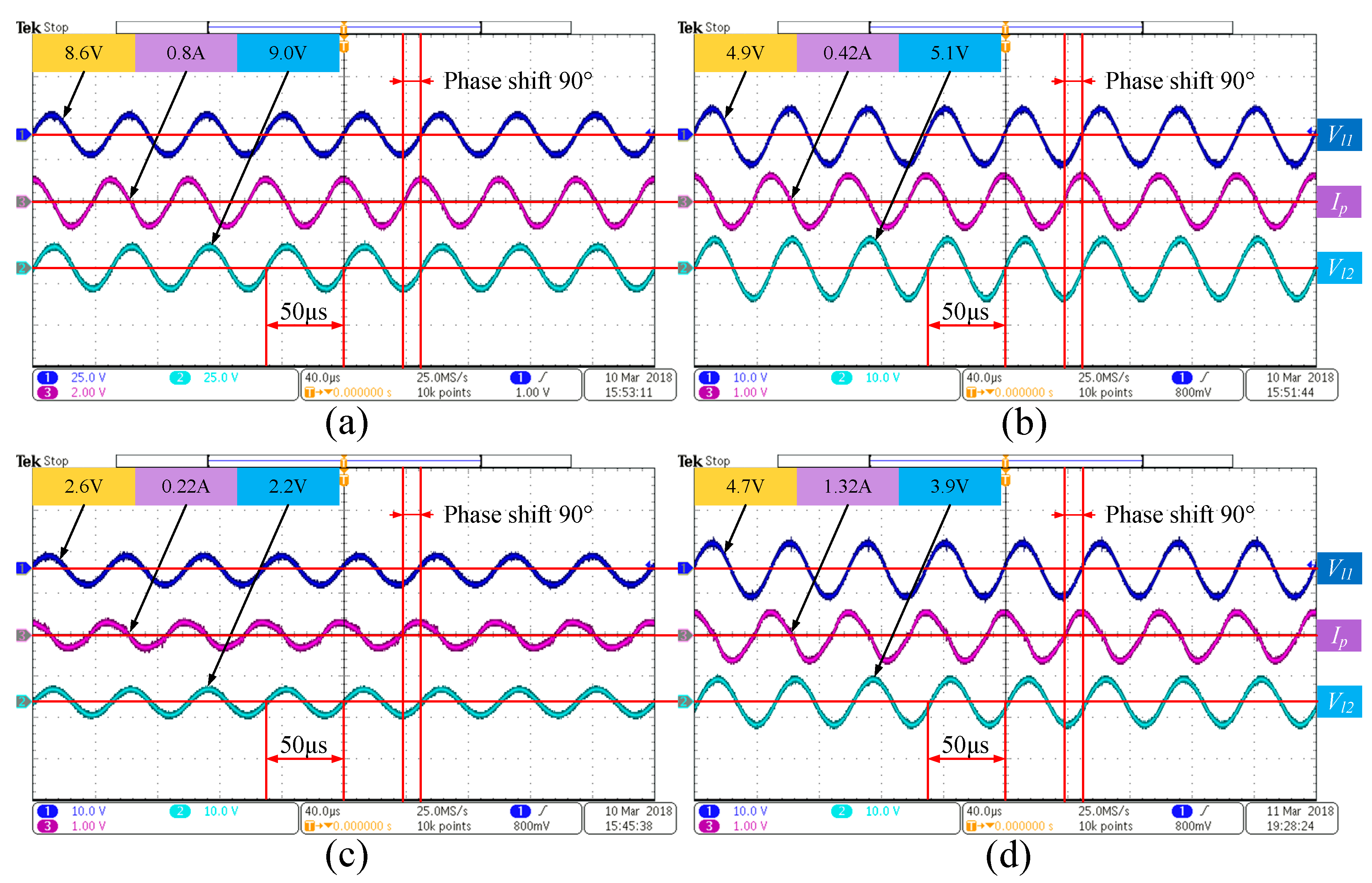
| Parameter | Symbol | Value |
|---|---|---|
| Real impedance of Load 1 | R1 | 100 Ω |
| Real impedance of Load 2 | R2 | 100 Ω |
| Real impedance of Load 3 | R3 | 100 Ω |
| Demand power range of Load 1 | Pr1 | 18–40 W |
| Demand power range of Load 2 | Pr2 | 35–45 W |
| Demand power range of Load 3 | Pr3 | 27–40 W |
| Power demand range of EV 1 | PEr1 | 4500–5500 W |
| Power demand range of EV 2 | PEr2 | 2700–3300 W |
| Power demand range of EV 3 | PEr3 | 1800–2200 W |
| Power error tolerance | eP | 10% |
| Excitation coil inductance | Lex | 1 mH |
| Receptor inductance | Lre | 400 μH |
| Power supply voltage | uex | 200 V |
| Working frequency | f | 20 kHz |
© 2018 by the authors. Licensee MDPI, Basel, Switzerland. This article is an open access article distributed under the terms and conditions of the Creative Commons Attribution (CC BY) license (http://creativecommons.org/licenses/by/4.0/).
Share and Cite
Zhang, Z.; Tong, R.; Liang, Z.; Liu, C.; Wang, J. Analysis and Control of Optimal Power Distribution for Multi-Objective Wireless Charging Systems. Energies 2018, 11, 1726. https://doi.org/10.3390/en11071726
Zhang Z, Tong R, Liang Z, Liu C, Wang J. Analysis and Control of Optimal Power Distribution for Multi-Objective Wireless Charging Systems. Energies. 2018; 11(7):1726. https://doi.org/10.3390/en11071726
Chicago/Turabian StyleZhang, Zhen, Ruilin Tong, Zhenyan Liang, Chunhua Liu, and Jiang Wang. 2018. "Analysis and Control of Optimal Power Distribution for Multi-Objective Wireless Charging Systems" Energies 11, no. 7: 1726. https://doi.org/10.3390/en11071726
APA StyleZhang, Z., Tong, R., Liang, Z., Liu, C., & Wang, J. (2018). Analysis and Control of Optimal Power Distribution for Multi-Objective Wireless Charging Systems. Energies, 11(7), 1726. https://doi.org/10.3390/en11071726






